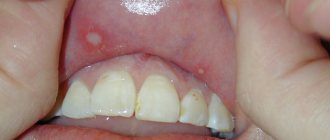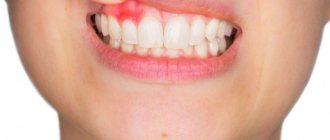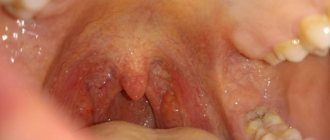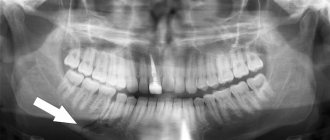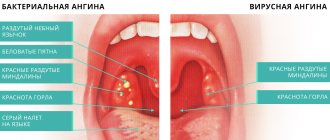A blood bubble, ball, or blister appears on the gum, tongue or cheek - this is a sign that the oral mucosa cannot perform its function fully.
Balls and blisters in the mouth filled with blood are a type of hematoma or bruise. Essentially, this is a small hemorrhage due to the fact that the capillaries or thin vessels on the mucous membrane have been injured.
If the bubble is without blood, and the liquid there is transparent, it means that there is no damage to the blood vessels, and the wound is superficial.
Injuries that may result in a blood globule appearing in the mouth:
- trauma due to a bitten cheek or damage from a hard object,
- severe irritation from a chemical substance, including too salty or spicy food,
- temperature effects when consuming very cold or hot drinks or foods.
Symptoms of bubbles in the mouth with photos
Blood balls or blisters in the mouth are a symptom of the diseases that lead to their appearance. Sometimes formations are visible in a regular mirror. Groups of small whitish or transparent blisters appear in the mouth, and a white or yellowish coating forms on the affected area, but sometimes you can find that a single large bloody blister has appeared inside the cheek or lower lip.
READ ALSO: what to do if a blister pops up on your lip?
You can see what a blood bubble in the mouth looks like in the photo accompanying the article. In addition to vesicles, symptoms are noted:
- feeling of dry mouth,
- slight swelling of the affected tissues,
- there is discomfort while eating,
- itching, pain, tingling and/or burning are felt in the oral cavity.
Causes of a blood ball in the mouth
Most often, a blood ball in the mouth is formed under the influence of external irritants and periodically, less often, is chronic. If there is an infection (viral or bacterial), the mucous membrane in the oral cavity also changes, which can lead to the formation of a ball. If it is present, depending on the size, a person feels acute pain when eating food with acid, drinking juices or plain water.
Main reasons:
- mechanical - biting the cheek or hard food can disrupt the integrity of the oral cavity, and since there is a large number of bacteria in the mucous membrane, a ball forms or this place becomes inflamed
- thermal - burn from hot or cold food
- chemical - food that is too salty or seasoned with spices disrupts the mucous membrane in the oral cavity, which can lead to the formation of a ball in different places
- pathological - stomatitis, thrush, tumor, hemangioma, diseases of the gastrointestinal tract or endocrine system - in the case of such pathologies, the mucous membrane is damaged, or rather its protective properties for the oral cavity decrease and wounds, pustules and blood globules form in it
Causes of blistering rash
If a rash or blisters appear in your mouth, you first need to determine the reason why they occurred (see also: blister on the gum: how to get rid of a blister on the gum?). At their core, such rashes act as a sign of a pathological condition, so if it is incorrect to determine why they occurred, it will be almost impossible to choose an effective treatment.
Herpes infection
Numerous white blisters on the lips may appear due to the development of a herpes infection. The disease affects people of any age, including small children.
Experts distinguish two forms of the disease – primary and recurrent, each of which has its own symptoms.
- small vesicles appear on the gums and in the vestibule of the mouth,
- they unite and burst, ulcers form, covered with a yellowish crust,
- drinking, eating, talking are difficult due to pain
- pain and slight itching,
- the skin and mucous membranes become red and slightly swollen,
- small blisters form, painful ulcers with jagged edges appear,
- erosions become covered with crusts or plaque,
- healing of the affected areas occurs.
Thrush or candidiasis
Individual small vesicles in the mouth are a likely sign of the development of one of the forms of thrush - candidal cheilitis. Often occurs inside the lower lip. In addition to the appearance of blisters, which merge into a white film as the disease progresses, a feeling of tightness and severe itching appears. In an advanced state, candidiasis can cause nausea, headaches, indigestion, irritability and bad breath.
Dermatitis of various types
The formation of blisters of various sizes on the skin and mucous membranes, including in the mouth and on the skin, is one of the signs of diseases belonging to the group of bullous dermatitis. The risk group includes adult men aged 30 to 40 years; women become infected with pemphigus of the oral mucosa less often. Pemphigus vulgaris of the oral cavity affects children very rarely.
There are 4 forms of oral pemphigus:
- pemphigus vulgaris of the oral cavity - the first sign is the appearance of blisters on the mucous membrane in the oral cavity,
- pemphigus vegetans - symptoms are localized in the groin and armpits,
- seborrheic pemphigus - affects the scalp and face,
- pemphigus foliaceus - the formation of blisters affects the entire surface of the body, but not the oral cavity.
Special mention should be made of Dühring's dermatitis herpetiformis. Similar to pemphigus vulgaris. It is characterized by symptoms such as fever, general weakness and malaise, and itching. Rashes occur on almost any part of the skin of the body, but not on the palms and soles. Sometimes pathology leads to the formation of blisters. They are small and usually filled with clear liquid.
Other reasons
In addition to the diseases listed above, there is a whole range of reasons that can provoke the formation of blisters, fluid-filled blisters in the mouth (see also: for what reasons can a bubble form under the tongue and how to eliminate it?). Not all of them are associated with pathological conditions of the body - in some cases we are talking about banal injuries or damage to the mucous membrane.
READ ALSO: reasons why we habitually bite our cheeks from the inside
Causes
The most common reason why blood blisters appear in the mouth is an accidental injury to the mucous membrane. There are three possible damage options:
Mechanical
A blood blister is formed when accidentally biting while talking or eating. The mucous membrane can also be injured:
- hard foods: candies, crackers, bones;
- broken, chipped teeth or incorrectly made dental structures: braces, bridges, crowns, dentures;
- during hygiene procedures - tissues are damaged due to careless movements while brushing teeth with a brush or toothpick.
In addition, you can bite your cheek during an epileptic seizure, during sleep, or during severe excitement. In these cases, the patient may not remember the moment the injury occurred.
A blister may appear after biting with your teeth.
Important! Less commonly, a bloody blister can form due to dental surgery. It is associated with careless actions of the doctor during sanitation of the oral cavity.
Thermal
A blister on the cheek can form when the mucous membrane is burned by hot drinks, dishes, when inhaling steam or accidentally touching heated cutlery. In this case, the appearance of a bubble is accompanied by a burning sensation, swelling, redness and slight pain.
Chemical
The cause is tissue damage by aggressive chemical elements: accidental ingestion or inhalation of vapors at home or at work may cause bubbles to appear. As with thermal injury, mucosal hyperemia and painful sensations are observed.
Important! Provoking factors for the appearance of blisters in the oral cavity include smoking, abuse of strong alcohol, and hypovitaminosis. It is believed that under the influence of harmful elements and a lack of vitamins, the walls of blood vessels become thinner. This provokes hemorrhage and the formation of hematomas.
Traumatic causes are typical for single bloody or serous formations. If bubbles appear regularly, there are many of them, they are localized not only on the cheek, but also on the tongue, gums, lips, and are accompanied by other symptoms (plaque, itching, unpleasant odor) - this indicates diseases of the oral cavity or systemic pathologies. Among these factors are:
- stomatitis;
- syphilis in the mouth;
- tuberculosis;
- disruption of the gastrointestinal tract;
- diseases of the endocrine system;
- hemangioma;
- vascular tumor;
- pemphigus.
Provoking factors for the appearance of blisters in the oral cavity include smoking, abuse of strong alcohol, and hypovitaminosis.
Characteristics of a blood bubble on the oral mucosa
The mucous membrane protects the entire body from the negative influence of the environment, from harmful microorganisms, various types of pollution, and also has a fairly high level of regeneration.
If blood blisters regularly appear on the oral mucosa, then you should take this signal seriously and take action. A bloody ball in the mouth is a hematoma (bruise), which is characterized by the accumulation of blood in a certain place in the oral cavity. The appearance of bloody blisters is a kind of hemorrhage that occurs due to trauma to the capillaries and thin vessels of the mucous membrane.
A blister on the mucous membrane may contain clear serous fluid without the presence of blood. This means that the vessels were not damaged and the resulting wound is superficial. Such blisters on the mucous membrane heal much faster. The presence of blood in the bladder indicates a deep injury and a longer period of healing and blood resorption.
The main causes of a blood blister
The general condition and integrity of the oral mucosa usually indicates the level of health of the body. Often, by examining the appearance of the oral mucosa and blisters, the doctor makes a final diagnosis. After all, the symptoms of most infectious, bacterial, chronic, and acute processes that occur in the body are associated with changes in the integrity and color of the oral mucosa. Therefore, it is important to understand the main reasons that cause blood blisters to appear in the mouth.
The mechanism of formation of a blood bubble on the oral mucosa
Bloody blisters in the mouth in most cases are not life-threatening. They are formed as a result of mechanical damage to the mucous membrane. When microtrauma occurs, harmful microorganisms attack the damaged area.
After this, a number of responses are activated in the human body:
- The immune system is activated. Monocytes and leukocytes, as well as macrophages, instantly arrive at the damaged area, attacking the harmful pathogen and quickly destroying it.
- Immune cells die. This is a signal for other cells and substances are released in the affected area that are mediators of inflammation of the mucous membrane - serotonin, histamine and bradykinin.
- These substances cause a strong spasm of the circulatory system and the outflow of blood is hampered. After the spasm is relieved, all accumulated blood immediately flows to the site of inflammation. It moves at high speed and under pressure. A detachment of the mucous membrane occurs in the mouth, and a bloody blister appears.
Blood blisters
The cheeks, due to their vital importance, are well protected, this is how it happened evolutionarily. Therefore, the muscle and mucous tissue of the cheeks are well innervated and richly vascularized, that is, supplied with blood. However, it also happens that this seemingly useful process becomes a problem. Many people are faced with the fact that a blood ball appears in the mouth on the mucous membrane of the cheek. Often such formation does not foreshadow anything dangerous. A blood bubble that forms in the mouth on the cheek is just the result of a mechanical injury. Most likely, the cheek area was bitten by the teeth while eating or talking. Since the oral cavity is a complex biological system in which a huge number of microorganisms live, it is natural that when such a microtrauma occurs, it becomes contaminated with various kinds of pathogens. As a result, a whole cascade of body responses is activated:
- since the pathogen is a foreign substance in the inner layer of the cheek, the immune system is immediately activated. Leukocytes, monocytes and macrophages quickly arrive at the site of infection, capture the pathogen and destroy it, and often die themselves;
- due to the death of immune cells that have absorbed pathogenic microflora, their internal contents are released into the environment. These biologically active substances are chemotaxis factors, that is, they signal to other cells, as a result of which substances such as histamine, serotonin, bradykinin - inflammatory mediators - are released in the area of inflammation;
- inflammatory mediators cause spasm of the circulatory system, which makes blood flow difficult; and after some time the vessels relax, and all the blood that has accumulated at the site of narrowing immediately flows into the source of inflammation. Since such blood flows at high speed and under high pressure, it forms a detachment of the mucous membrane - a bubble - and a blood ball appears in the mouth.
Thus, the blood blisters that form in the mouth are just part of the body's defense mechanism, which has been formed over centuries. When such a pathology appears, you should not panic too much. Regular blood blisters reorganize on their own within 3-4 days. But if the blood bubble does not self-destruct within a week, consult a dentist to rule out the diagnosis of unwanted neoplasms. The doctor will not only prescribe a pain reliever (since the appearance of a neoplasm on the mucous membrane is sometimes accompanied by pain), but will also take a sample of the epithelium for histology analysis.
Treatment of bloody blisters in the mouth
A blood blister in the mouth is only part of the body’s defense reaction and goes away on its own within a week. If this does not happen, then you should consult a doctor to rule out serious diseases of the body and neoplasms. He will be able to make an accurate diagnosis after a thorough examination, studying the data of clinical tests and histology. After this, the doctor will prescribe the correct treatment.
The process of treating a blood bladder in the oral cavity is closely related to the cause of its appearance and therefore treatment depends on several important factors:
- volume of surface damage;
- degree of filling with serous fluid;
- the nature of the contents of the blood bladder;
- location.
The volume and nature of the damaged surface is important when prescribing treatment for a bloody blister in the oral cavity. After all, the larger the volume of the blood bladder, the worse it heals and resolves. Treatment of a large bladder with blood can develop from conservative treatment into surgical intervention. Small blood blisters resolve quickly and do not require special treatment.
A blood blister on the oral mucosa must be carefully examined to exclude hemangioma and vascular tumor. A doctor can do this when examining the oral cavity. Hemangioma is sometimes left without much treatment if it does not grow. If it grows rapidly, it should be removed surgically.
Many bloody blisters in the mouth can be associated with syphilis, sometimes pemphigus. Small red blisters on, under, or on the side of the tongue may indicate the presence of glossitis, an inflammation of the surface of the tongue caused by harmful microorganisms. Treatment will consist of treating and rinsing the mouth with antiseptic solutions and eliminating the disease, which was the main cause of the appearance of blood blisters.
It is not necessary to treat a bloody blister in the mouth if it is isolated and does not bother the person. If it interferes, the doctor performs a puncture after a thorough examination and diagnosis.
To strengthen the walls of blood vessels and the immune system, vitamins E, A, C, K, B vitamins, and multivitamin complexes are prescribed.
The appearance of bloody blisters in the mouth indicates an oral injury or is a symptom of a disease in the body. Only a doctor can establish the true cause of this formation and prescribe effective treatment. If you seek qualified help in time, this disease will not cause discomfort and will not lead to serious consequences.
The mechanism of formation of bubbles in the mouth
A blister on the inside of the cheek is a hematoma, or bruise. It is a small, from a few millimeters to a couple of centimeters, rounded formation. The internal exudate is serous or bloody, depending on the extent of the injury. In the first case, the blister is gray-white, in the second it is red, with a possible bluish tint.
Blood blisters appear due to injuries to the mucous membrane. Their formation is a natural reaction of the immune system to an irritant. It consists in:
- Activation of the body's defense mechanisms in response to an irritant. Agranulocytes arrive at the site of the lesion: leukocytes and monocytes. The latter, when leaving the blood into the tissues, are converted into macrophages. These cells capture the pathogen, neutralize it, and then die.
- The death of agranulocytes leads to their release to the site of injury. This process is a signal of injury to the body. After which it begins to release histamine, bradykinin and serotonin into the affected area. They sharply increase the permeability of blood vessels.
- A spasm occurs at the site of injury. The blood flow becomes difficult, after which the vessels relax and the blood accumulated during the narrowing enters the injured area. It moves quickly and under pressure. As a result, the upper layer of the epithelium peels off and a blister filled with bloody contents forms.
Blood blisters appear due to injuries to the mucous membrane.
Important! The red or white growth is not dangerous. It is virtually painless and heals within a week. The only discomfort is associated with inconvenience when chewing and talking.
Reasons why a blood bubble appears on the tongue and under it
A blood bubble on the tongue is nothing more than a hematoma.
The tension of the epithelial covers over the wound area in combination with many nerve endings causes acute pain and itching. Bruising may occur due to rupture of blood vessels.
The appearance of formations in the form of blisters on the mucous membrane can be combined into two groups:
Most often, rupture of blood vessels occurs when the integrity of the mucous membrane is violated. Development factors can be:
- Mechanical injuries. Lollipops, fish bones, grilled meats, chips - these are a few typical enemies of healthy mucous membranes. Sharp or hard components can puncture the vessel and cause hemorrhage. Often similar phenomena are observed in children under three years of age who “taste the world.” In the dentist's office there is also a high probability of mechanical trauma to the mucous membrane.
- Chemical damage. The circulatory network of the oral cavity is very sensitive to external stimuli. Spicy, salty foods, carbonated drinks filled with dyes and flavorings - all the delights of the food industry have a detrimental effect on the delicate mucous membrane.
- Thermal impact. A fluid-filled blister on the tongue may be a common burn from tea or hot food.
Blood blister as a symptom of the disease
Often, bloody blisters are symptoms of other diseases, including viral, hematological, and autoimmune diseases:
- Herpes. It is possible that a herpetic blister can appear in any area of the tongue and under it. In this case, an additional signal will be an increase in temperature, body aches, and headache. The herpes blister is filled with transparent contents, after 2-3 days it decreases in size and begins to resemble a pimple in appearance.
- Herpetic sore throat. Blisters in the throat with herpangina can spread to the tongue area. This is especially true for the root of the tongue.
- Stomatitis. The most common cause of blood blisters on the tongue is stomatitis. Most often, the disease is encountered in childhood, but adults can also get stomatitis. The disease progresses with acute pain, blistering rashes cover the entire oral mucosa, and the temperature rises.
- Diabetes. The vascular system becomes very vulnerable. The walls of blood vessels that lose elasticity are unable to fully pump blood. That is why in one of the most delicate places, on the tongue, a rupture of blood vessels occurs, followed by an outpouring of blood.
- Syphilis. Formations in the form of blisters with blood are symptoms of syphilis. The disease often affects the oral cavity and primarily manifests itself as a rash in the area of the throat and tongue. Bloody blisters can also appear in later stages of syphilis, because frequent hemorrhages accompany the disease. To differentiate a sexually transmitted disease, an analysis is carried out for the content of Treponema pallidum in the blood.
- Pemphigus. A blood blister on the tongue is also a symptom of pemphigus. This is a dangerous disease with a possible fatal outcome. A characteristic symptom is detachment of epithelial tissue with the formation of blisters. Healing after opening of the blisters is long and painful, complicated by erosions.
- Hemangioma. Abnormal growth of vascular tissue with subsequent tumor formation is a dangerous disease. Although there have been no recorded cases of transformation of hemangioma into a malignant tumor in medicine, it is still important not to miss the growth of the tumor. At first glance, a hemangioma resembles an ordinary post-traumatic blood bladder. However, after a few days the tumor may already increase in size. A hemangioma on the tongue and under it can block the air flow, and its independent puncture is fraught with blood loss, because the vessel is enlarged in size.
- Angiosarcoma. Not all tongue blisters are benign. A rare cancer, Cauchy's sarcoma resembles a hematoma in the mouth in appearance, but unlike a blister, the tumor has jagged edges and a heterogeneous structure. The disease in most cases is a complication of HIV infection and provides grounds for the diagnosis of AIDS.
Types of tumors on the inside of the cheek with photos
Typically, compaction formation begins with mechanical damage. The appearance of a tumor on the inside of the cheek is caused by a number of reasons:
- injury to the mucous membrane by the sharp edge of a tooth or prosthesis;
- exposure to alcohol combined with smoking;
- viral infection.
The most common viral infection leading to the formation of compacted tissue is human papillomavirus. In children, tumors may be a consequence of impaired tissue differentiation during the prenatal period.
- Seals consisting of epithelial cells are called epithelial. The most common are papillomas, nevi and Serra glands.
- The proliferation of connective tissues leads to the formation of fibromas, myomas, myxomas, pyogenic granulomas, epulises and neuromas. Compacted tissue is formed from cells of the mucous membrane, muscle tissue, and the sheath of nerve fibers.
- Tumors of vascular origin are represented by hemangiomas and lymphogiomas. This type of tumor is soft and shrinks in size when pressed.
Causes of compaction
A dense ball on the inner surface of the mucosa is often a consequence of inflammation, the process is caused by dental reasons. Redness and swelling occur after tooth extraction, during the eruption of wisdom teeth, or as a result of gum disease.
An infection that affects the root of a tooth with insufficient treatment leads to the formation of a focus of inflammation in the pulp chamber. The development of infection occurs more actively in a weakened body.
Inflammation of the salivary gland or lymph nodes can also lead to the appearance of a dense formation in the mouth (we recommend reading: inflammation of the salivary glands: signs with photos and treatment). Edema is provoked by various infections, colds, and mechanical blockage of the salivary duct. The process can spread to the entire cheek and eye area.
A small, gradually enlarging bump on the inside of the cheek may be a wen (lipoma). A characteristic sign of a lipoma is a ball rolling under the fingers. Different types of seals on the oral mucosa are presented in the photo.
Biting injury
A cheek injured by biting is exposed to pathogens that enter the mouth with food. By penetrating into the mucous membrane through a damaged area, they can cause a number of diseases:
- aphthous stomatitis is caused by pathogens of herpes, measles, influenza, diphtheria, as well as adenovirus and L-form staphylococci, and occurs with relapses;
- herpetic stomatitis causes the formation of small painful ulcers, cured within a week;
- children may develop Bednar's aphthae; the formations have a yellowish tint and develop due to poor oral hygiene;
- a traumatic ulcer is formed both as a result of biting and brushing teeth (we recommend reading: methods of treating traumatic ulcers in the mouth: drugs and folk remedies).
How to treat bloody blisters in the mouth.
First, the doctor carefully examines the oral cavity, assesses the damage, volume, location and contents of the blood cell. It is necessary to determine whether this neoplasm is a hemangioma, a vascular tumor, or a symptom of glossitis and other diseases.
Treatment is prescribed only if the blister is too large and bothers the patient. Then the doctor will recommend minimal surgical intervention to speed up the solution to the problem. Rinsing with an antiseptic solution and vitamin complexes may also be prescribed to strengthen the walls of blood vessels and the immune system.
If the blood bubble is too large, bothers you and does not resolve within a week, be sure to seek help from our specialists.
Our dentists will professionally diagnose, prescribe adequate treatment and solve your problem without letting it develop into something serious.
Click and find out why such blisters appear, how they are treated and what the prognosis for recovery is.
Treatment of a bump on the cheek
Any neoplasm on the cheek from the inside interferes with chewing and is constantly injured. The patient is indicated for surgical treatment to relieve discomfort and prevent cancer. Removal is carried out in several ways:
- cryodestruction – destruction of neoplasms using low temperatures (liquid nitrogen);
- sclerotherapy - the introduction of a drug into a vessel that causes the walls to stick together and then resolve;
- laser – layer-by-layer removal of the cyst and its contents with a laser scalpel;
- radio wave method - removal of high-frequency radio waves by a beam;
- surgical excision with a scalpel.
If the cause of the tumor was a viral infection, surgical methods are supplemented with antiviral drug therapy. Sometimes folk remedies help, but they cannot cope with the cause of the disease.
Medicines
The development of a tumor on the mucous membrane, which is viral in nature, is treated with interferon-based drugs. They help the body cope with the disease and have a general strengthening effect.
- These drugs include: Viferon, Intron, Altevir, Roferon.
- Taking vitamins is indicated, antiviral treatment is carried out with Lavomax, Cycloferon and others.
- To stop tumor growth, cytostatics may be prescribed.
Hot and cold compresses cannot be used to treat growths: they can worsen the situation and contribute to the exacerbation of the disease. For home remedies, you can try applications with castor oil; it is recommended to repeat them twice a day. It is also suggested to wipe the growth with a cut clove of garlic, but in the case of an ulcer or erosion, such treatment is more likely to harm.
Rinse
Rinsing is useful only at the initial stage, after biting or the appearance of a small dense area.
- A decoction of oak bark will help you cope with inflammation and defeat infection. You should rinse your mouth at least 7 times a day for a week.
- Pine needles will also help. They need to be crushed, steamed in a thermos and used after brushing your teeth.
Treatment
Usually a bloody blister does not require specific treatment. Since it is a natural response of the immune system to external stimuli, the formation goes away on its own within a few days.
Important! If the resulting blister did not appear due to injury, often recurs, or multiple growths are noted, a doctor’s consultation is required to rule out possible pathologies.
In some cases, therapy for hematoma is indicated. It is required for large bladder size, pain and discomfort. When treating, the dentist takes into account the following factors:
- size of education;
- time and factor of appearance;
- location of the bubble: on the cheek, tongue, lip, gums;
- whether there are other blisters or sores.
If the bubble does not go away, contact your dentist.
Treatment of a bloody ball consists of a puncture, ensuring the outflow of accumulated fluid and antiseptic treatment. Rarely, surgical excision of tissue is required to remove the lesion.
When blisters appear due to chipped teeth or incorrect dental work, the defects must be corrected. Otherwise, the cheek will be constantly injured.
Important! If the doctor suspects that the bubbles have formed not due to injuries, but as a consequence of systemic pathologies, the patient will be prescribed a comprehensive examination. Further therapy will be based on test results.
According to indications, multivitamin complexes with a high content of vitamins C, K, E, A, and group B can be prescribed. This will strengthen the walls of blood vessels and prevent hemorrhages.
After surgery, the patient is recommended to:
- stop smoking and drinking alcohol for a while;
- do not eat food that irritates the mucous membranes: salty, smoked, spicy, pickled, rough;
- treat the oral cavity with medicinal solutions and herbal infusions with an antiseptic and wound-healing effect: chlorhexidine, miraministin, soda-saline solution, decoctions of chamomile, oak bark, sage.
To be safe from complications, rinse your mouth with an antiseptic solution for several days.
What can and cannot be done if a blister appears on the cheek?
The formation of a blood globule is always a cause for concern. However, there is no need to panic. First of all, it is necessary to establish the reason why it could appear: whether there were injuries, whether hot or irritating food was consumed. Further actions are aimed at relieving inflammation and disinfection:
- The mouth is treated with antiseptic drugs.
- Rinsing with a solution of baking soda and salt will help relieve inflammation.
- Provoking factors are excluded: smoking, alcohol, consumption of salty, sour, spicy, pickled foods.
If after a few days the ball does not shrink and signs of healing are not visible, you should consult a doctor: dentist or therapist.
It is strictly forbidden to pierce the formation yourself. This can lead to infection or even greater injury.
Bloody blisters in the mouth most often appear as a result of injuries: biting, burns, chemical injuries. Less common factors are diseases of the oral cavity and systemic pathologies. As a rule, no special treatment is required. If the formation interferes, the dentist pierces it and prescribes antiseptic treatment.

